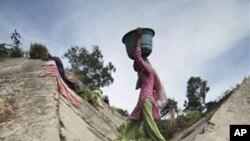U.N. World Water Day is a reminder that some of the world's looming water crises are urgent and vast in scope. That is especially true in South Asia, where hundreds of millions of the world's poorest residents lack basic water infrastructure, and where access to natural water supplies is set to become ever more competitive.
U.S. intelligence officials believe water scarcity is shaping up to be one of the main potential drivers of future global conflict.
In his 12 years on a U.S. Congressional intelligence committee, U.S. Ambassador to India Timothy Roemer says he had regular access to reports about transnational issues U.S. officials believed could spark conflict or even war. He says the prominence of water issues in those reports evolved rapidly from the 1990s forward.
"We saw issues like al-Qaida and technology, and water was about 10th or 11th on that list," said Roemer. "By the 2025 projected report, water was in the top five."
India's population of more than a billion people is widely expected to overtake the population of China by the middle of the 21st century. Both countries depend on a handful of major waterways originating in the Himalayan mountain range. One of those is known to Indians as the Brahmaputra, running through Chinese-controlled Tibet and into the eastern Indian state of Arunachal Pradesh.
Indian officials are closely monitoring Chinese plans to build a hydroelectric dam along that waterway. They say, during an India-China summit late last year, Beijing offered assurances it would do nothing to affect the supply of water downstream. The discussions are made more tense by the fact that China does not fully recognize India's sovereignty over Arunachal Pradesh. On official Chinese maps, the Indian state shows up as "Southern Tibet."
For hundreds of millions of Indians, lack of water is not a question of geopolitics, but lack of infrastructure for water delivery and purification. Ambassador Roemer says India's water crisis often affects the poorest, and the youngest.
"We all know small villages where, when you say hello, and you hug 10 children in that village, two or three of them may not be there four or five years from now due to problems that they have just getting access to clean and potable water," he said.
India's challenge in delivering basic sanitation and water supplies to the majority of its citizens is part of what Environment Minister Jairam Ramesh describes as a broader problem of "ecological poverty," which contrasts with India's growing wealth as an industrial and technological power.
"The reason why India must take environment seriously is because it is becoming a very serious public health concern," said Ramesh. "A public health concern not for the rich or for the middle classes, but it is becoming a public health concern for the poor."
Ramesh says India has undertaken a 10-year program to ensure no untreated industrial effluent or urban sewage is released into the country's main river, the Ganges. He says man-made pollution is one of the main contaminants of India's groundwater, upon which hundreds of millions of Indians depend for consumption and agriculture.
"Water quality is something that's absolutely essential," he said. "And we need to address some of these issues in a much more systematic manner than we have."
One of the most dramatic warnings about India's groundwater supply comes from Dipankar Chakraborti, director of environmental studies at Javadpur University in the Indian State of West Bengal. He was one of the first to point out decades ago the problem of arsenic contamination in deep water wells in West Bengal and Bangladesh.
Chakraborti predicts the health crisis of arsenic contamination will not be limited to northeast India and Bangladesh, but will emerge in the coming decades along the flood plains of the Ganges and other transnational waterways.
India Could Face Water Woes In Coming Decades
- By Kurt Achin









